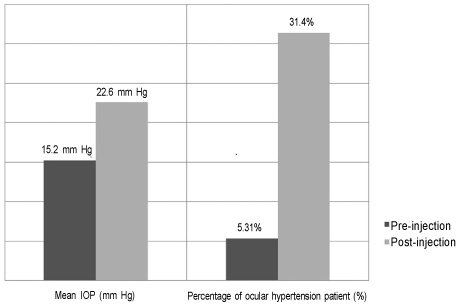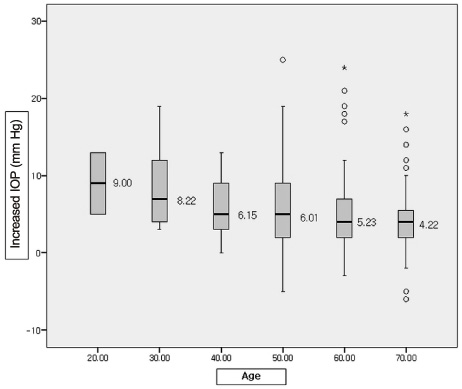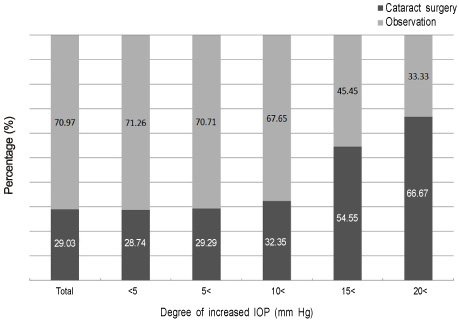J Korean Ophthalmol Soc.
2012 Jan;53(1):76-86. 10.3341/jkos.2012.53.1.76.
Complications after Intravitreal Triamcinolone Acetonide Injection: Incidence and Risk Factors
- Affiliations
-
- 1Department of Ophthalmology, Inha University School of Medicine, Incheon, Korea. hschin@inha.ac.kr
- KMID: 2215248
- DOI: http://doi.org/10.3341/jkos.2012.53.1.76
Abstract
- PURPOSE
To reduce complications and provide proper management for better clinical outcomes in the treatment of macular edema through a large-scale analysis of the incidence and risk factors for complications of intravitreal triamcinolone injection.
METHODS
The medical records of 490 eyes that received intravitreal triamcinolone (4.0 mg) injection for treatment of macular edema caused by various diseases were retrospectively reviewed, and relevant parameters were included in a multivariate regression model.
RESULTS
Vitrectomized (p < 0.001) and pseudophakic (p = 0.054) eyes were less likely to exhibit an intraocular pressure increase, but glaucoma (p < 0.001) and young age (p = 0.073) were found to be significant risk factors for this complication. Vitrectomized eyes (p = 0.011), diabetic macular edema (p < 0.001), secondary ocular hypertension (p = 0.029) and old age (p = 0.059) were associated with cataract progression. Three consecutive case of sterile endophthalmitis, which differs from bacterial endophthalmitis in clinical course and prognosis, occurred during the same period.
CONCLUSIONS
Risk factors and the incidence of complications after intravitreal triamcinolone injection should be evaluated through regular follow-up evaluation to ensure proper management and a better prognosis.
Keyword
MeSH Terms
Figure
Cited by 2 articles
-
Intraocular Pressure: Intravitreal Preservative-free Triamcinolone Injection in Diabetic Macular Edema and Branch Retinal Vein Occlusion
Chan Ho Lee, Young Seung Seo
J Korean Ophthalmol Soc. 2020;61(2):167-174. doi: 10.3341/jkos.2020.61.2.167.Intraocular Pressure Elevation after 0.7 mg Intravitreal Dexamethasone (Ozurdex®) Implantation: A One Year Follow-Up
Dae Hyun Park, Seung Joo Ha, Sung Jin Lee
J Korean Ophthalmol Soc. 2015;56(6):891-899. doi: 10.3341/jkos.2015.56.6.891.
Reference
-
1. Machemer R, Sugita G, Tano Y. Treatment of intraocular proliferations with intravitreal steroids. Trans Am Ophthalmol Soc. 1979. 77:171–180.2. Martidis A, Duker JS, Greenberg PB, et al. Intravitreal triamcinolone for refractory diabetic macular edema. Ophthalmology. 2002. 109:920–927.3. Sutter FK, Simpson JM, Gillies MC. Intravitreal triamcinolone for diabetic macular edema that persists after laser treatment: three-month efficacy and safety results of a prospective, randomized, double-masked, placebo-controlled clinical trial. Ophthalmology. 2004. 111:2044–2049.4. Park CH, Jaffe GJ, Fekrat S. Intravitreal triamcinolone acetonide in eyes with cystoid macular edema associated with central retinal vein occlusion. Am J Ophthalmol. 2003. 136:419–425.5. Ip MS, Gottlieb JL, Kahana A, et al. Intravitreal triamcinolone for the treatment of macular edema associated with central retinal vein occlusion. Arch Ophthalmol. 2004. 122:1131–1136.6. Antcliff RJ, Spalton DJ, Stanford MR, et al. Intravitreal triamcinolone for uveitic cystoid macular edema: An optical coherence tomography study. Ophthalmology. 2001. 108:765–772.7. Conway MD, Canakis C, Livir-Rallatos C, Peyman GA. Intravitreal triamcinolone acetonide for refractory chronic pseudophakic cystoid macular edema. J Cataract Refract Surg. 2003. 29:27–33.8. Sutter FK, Gillies MC. Intravitreal triamcinolone for radiation induced macular edema. Arch Ophthalmol. 2003. 121:1491–1493.9. Danis RP, Ciulla TA, Pratt LM, Anliker W. Intravitreal triamcinolone acetonide in exudative age-related macular degeneration. Retina. 2000. 20:244–250.10. Ranson NT, Danis RP, Ciulla TA, Pratt L. Intravitreal triamcinolone in subfoveal recurrence of choroidal neovascularisation after laser treatment in macular degeneration. Br J Ophthalmol. 2002. 86:527–529.11. Jonas JB, Kreissig I, Degenring R. Repeated intravitreal injections of triamcinolone acetonide as treatment of progressive exudative age-related macular degeneration. Graefes Arch Clin Exp Ophthalmol. 2002. 240:873–874.12. Spaide RF, Sorenson J, Maranan L. Combined photodynamic therapy with verteporfin and intravitreal triamcinolone acetonide for choroidal neovascularization. Ophthalmology. 2003. 110:1517–1525.13. Peyman GA, Cheema R, Conway MD, Fang T. Triamcinolone acetonide as an aid to visualization of the vitreous and the posterior hyaloid during pars plana vitrectomy. Retina. 2000. 20:554–555.14. Ciardella AP, Klancnik J, Schif W, et al. Intravitreal triamcinolone for the treatment of refractory diabetic macular oedema with hard exudates: An optical coherence tomography study. Br J Ophthalmol. 2004. 88:1131–1136.15. Vasconcelos-Santos DV, Nehemy PG, Schachat AP, Nehemy MB. Secondary ocular hypertension after intravitreal injection of 4 mg of triamcinolone acetonide: incidence and risk factors. Retina. 2008. 28:573–580.16. Jung JW, Nam DH, Shyn KH. The Complications after Intravitreal Injection of Triamcinolone Acetonide. J Korean Ophthalmol Soc. 2007. 48:55–62.17. Özkiris A, Erkilic K. Complications of intravitreal injection of triamcinolone acetonide. Can J Ophthalmol. 2005. 40:63–68.18. Moshfeghi DM, Kaiser PK, Scott IU, et al. Acute endophthalmitis following intravitreal triamcinolone acetonide injection. Am J Ophthalmol. 2003. 136:791–796.19. Challa JK, Gillies MC, Penfold PL, et al. Exudative macular degeneration and intravitreal triamcinolone: 18 month follow up. Aust N Z J Ophthalmol. 1998. 26:277–281.20. Yang YH, Kim KR, Yang SW, Yim HB. The effect of intravitreal triamcinolone acetonide on intraocular pressure. J Korean Ophthalmol Soc. 2004. 45:1081–1085.21. Lee JM, Kim SJ, Yi KY, Kim HK. Intraocular Pressure Change After Secondary Intravitreal Triamcinolone Acetonide Injection. J Korean Ophthalmol Soc. 2007. 48:97–102.22. Park HY, Yi K, Kim HK. Intraocular pressure elevation after intravitreal triamcinolone acetonide injection. Korean J Ophthalmol. 2005. 19:122–127.23. Gillies MC, Kuzniarz M, Craig J, et al. Intravitreal triamcinolone-induced elevated intraocular pressure is associated with the development of posterior subcapsular cataract. Ophthalmology. 2005. 112:139–143.24. Rhee DJ, Peck RE, Belmont J, et al. Intraocular pressure alterations following intravitreal triamcinolone acetonide. Br J Ophthalmol. 2006. 90:999–1003.25. Jonas JB, Kreissig I, Degenring RF. Endophthalmitis after intravitreal injection of triamcinolone acetonide. Arch Ophthalmol. 2003. 121:1663–1664.26. Nelson ML, Tennant MT, Sivalingam A, et al. Infectious and presumed noninfectious endophalmitis after intravitreal triamcinolone acetonide injection. Retina. 2003. 23:686–691.27. Avci R, Kaderli B, Akalp FD. Intravitreal triamcinolone injection for chronic diffuse diabetic macular oedema. Clin Experiment Ophthalmol. 2006. 34:27–32.28. Kok H, Lau C, Maycock N, et al. Outcome of intravitreal triamcinolone in uveitis. Ophthalmology. 2005. 112:1916.e1–1916.e7.29. Wordinger RJ, Clark AF. Effects of glucocorticoids on the trabecular meshwork: towards a better understanding of glaucoma. Prog Retin Eye Res. 1999. 18:629–667.30. Kubota T, Okabe H, Hisatomi T, et al. Ultrastructure of the trabecular meshwork in secondary glaucoma eyes after intravitreal triamcinolone acetonide. J Glaucoma. 2006. 15:117–119.31. Scholes GN, O'Brein WJ, Abrams GW, et al. Clearance of triamcinolone from vitreous. Arch Ophthalmol. 1985. 103:1567–1569.32. Kim TH, Moon YS, Chin HS. Change of residual period and clearance rate of intravitreal triamcinolone according to initial dosage. J Korean Ophthalmol Soc. 2005. 46:1569–1574.33. Meyer CH, Mennel S, Schmidt JC. Intravitreal triamcinolone acetonide may increase the intraocular pressure even in vitrectomized eyes after more than 3 months. Am J Ophthalmol. 2005. 140:766–767.34. Kosobucki BR, Freeman WR, Cheng L. Photographic estimation of the duration of high dose intravitreal triamcinolone in the vitrectomised eye. Br J Ophthalmol. 2006. 90:705–708.35. Beer PM, Bakri SJ, Singh RJ, et al. Intraocular concentration and pharmacokinetics of triamcinolone acetonide after a single intravitreal injection. Ophthalmology. 2003. 110:681–686.36. Ito T, Nozaki M, Ogura Y. Incidence and risk factors of intraocular pressure elevation after triamcinolone acetonide administration for macular disorders. Nippon Ganka Gakkai Zasshi. 2006. 110:379–383.37. Jonas JB, Degenring RF, Kreissig I, et al. Intraocular pressure elevation after intravitreal triamcinolone acetonide injection. Ophthalmology. 2005. 112:593–598.38. Bashshur ZF, Terro AM, Haibi CP, et al. Intravitreal triamcinolone acetonide: Pattern of secondary intraocular pressure rise and possible risk factors. Clin Ophthalmol. 2008. 2:269–274.39. Vasconcelos-Santos DV, Nehemy PG, Schachat AP, Nehemy MB. Secondary ocular hypertension after intravitreal injection of 4 mg of triamcinolone acetonide. Retina. 2008. 28:573–580.40. Clark AF, Wilson K, McCartney MD, et al. Glucocorticoid-induced formation of cross-linked actin networks in cultured human trabecular meshwork cells. Invest Ophthalmol Vis Sci. 1994. 35:281–294.41. Wilson K, McCartney MD, Miggans ST, Clark AF. Dexamethasone induced ultrastructural changes in cultured human trabecular meshwork cells. Curr Eye Res. 1993. 12:783–793.42. Johnson DH, Bradley JM, Acott TS. The effect of dexamethasone on glycosaminoglycans of human trabecular meshwork in perfusion organ culture. Invest Ophthalmol Vis Sci. 1990. 31:2568–2571.43. Weinreb RN, Mitchell MD, Polansky JR. Prostaglandin production by human trabecular meshwork cells: in vitro inhibition by dexamethasone. Invest Ophthalmol Vis Sci. 1983. 24:1541–1545.44. Lee JM, Kim SJ, Yi KY, Kim HK. Intraocular pressure hange after secondary intravitreal triamcinolone acetonide injection. J Korean Ophthalmol Soc. 2007. 48:97–102.45. Kass MA, Sears ML. Hormonal regulation of intraocular pressure. Surv Ophthalmol. 1977. 22:153–176.46. Sampat KM, Garg SJ. Complications of intravitreal injections. Curr Opin Ophthalmol. 2010. 21:178–183.47. Vîrgolici B, Popescu L. Risk factors in cataract. Oftalmologia. 2006. 50:3–9.48. Stefánsson E. Physiology of vitreous surgery. Graefes Arch Clin Exp Ophthalmol. 2009. 247:147–163.49. Goel M, Picciani RG, Lee RK, Bhattacharya SK. Aqueous humor dynamics: a review. Open Ophthalmol J. 2010. 4:52–59.50. Gillies MC, Islam FM, Larsson J, et al. Triamcinolone-induced cataract in eyes with diabetic macular oedema: 3-year prospective data from a randomized clinical trial. Clin Experiment Ophthalmol. 2010. 38:605–612.51. Gillies MC, Kuzniarz M, Craig J, et al. Intravitreal triamcinolone-induced elevated intraocular pressure is associated with the development of posterior subcapsular cataract. Ophthalmology. 2005. 112:139–143.52. Jonas JB, Kreissig I, Degenring RF. Cataract surgery after intravitreal injection of triamcinolone acetonide. Eye. 2004. 18:361–364.53. Moshfeghi DM, Kaiser PK, Scott IU, et al. Acute endophthalmitis following intravitreal triamcinolone acetonide injection. Am J Ophthalmol. 2003. 136:791–796.54. Nelson ML, Tennant MT, Sivalingam A, et al. Infectious and presumed noninfectious endophthlamits after intravitreal triamcinolone acetonide injection. Retina. 2003. 23:686–691.55. Roth DB, Chieh J, Spirn MJ, et al. Noninfectious endophthalmitis associated with intravitreal triamcinolone injection. Arch Ophthalmol. 2003. 121:1279–1282.56. Jonas JB, Kreissig I, Degenring RF. Endophthalmitis after intravitreal injection of triamcinolone acetonide. Arch Ophthalmol. 2003. 121:1663–1664.57. Moshfeghi AA, Scott IU, Flynn HW Jr, Puliafito CA. Pseudohypopyon after intravitreal triamcinolone acetonide injection for cystoid macular edema. Am J Ophthalmol. 2004. 138:489–492.58. Jonas JB, Kreissig I, Spandau UH, Harder B. Infectious and noninfectious endophthalmitis after intravitreal high-dose triamcinolone acetonide. Am J Ophthalmol. 2006. 141:579–580.59. Sutter FK, Gillies MC. Pseudo-endophthalmitis after intravitreal injection of triamcinolone. Br J Ophthalmol. 2003. 87:972–974.60. Chen SD, Lochhead J, McDonald B, Patel CK. Pseudohypopyon after intravitreal triamcinolone injection for the treatment of psuedophakic cystoid macular oedema. Br J Ophthalmol. 2004. 88:843–844.
- Full Text Links
- Actions
-
Cited
- CITED
-
- Close
- Share
- Similar articles
-
- Intravitreal and Additional Posterior Subtenon Triamcinolone Injection in Diabetic Macular Edema
- Triamcinolone Regurgitation into Anterior Chamber after Intravitreal Triamcinolone Injection
- Clinical Manifestations of Intraocular Pressure Elevation after Intravitreal Injection of Triamcinolone Acetonide
- Change of Residual Period and Clearance Rate of Intravitreal Triamcinolone According to Initial Injection Dosage
- The Effect of Intravitreal Triamcinolone Acetonide on Intraocular Pressure




